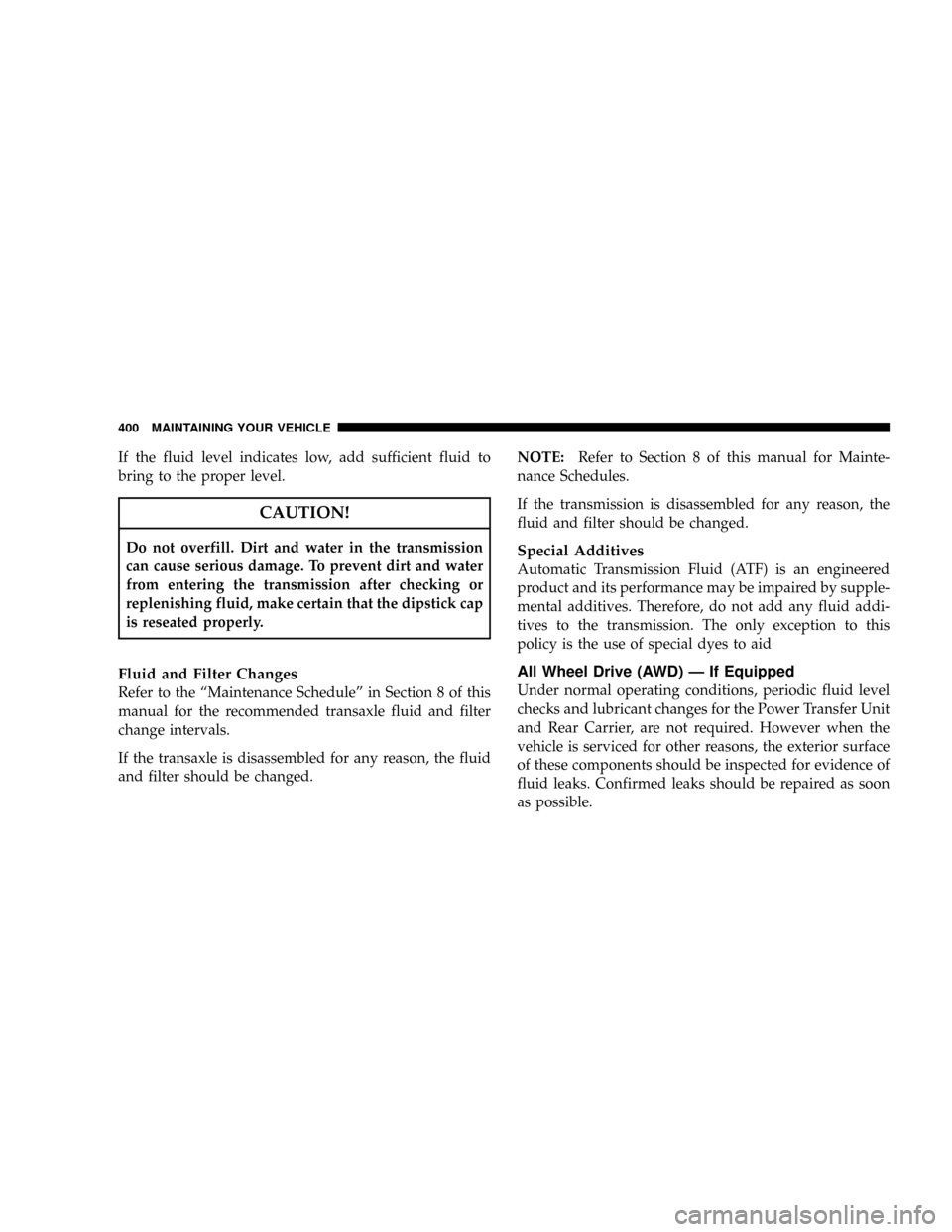Page 293 of 457

Shallow Standing Water
Although your vehicle is capable of driving through
shallow standing water, consider the following before
doing so:CAUTION!
²Always check the depth of the standing water before
driving through it. Never drive through standing water that
is deeper than the bottom of the tire rims mounted on the
vehicle.
²Determine the condition of the road or the path that is
under water and if there are any obstacles in the way before
driving through the standing water.
²Do not exceed 5 mph (8 km/h) when driving through
standing water. This will minimize wave effects.
²Driving through standing water may cause damage to your
vehicle's drivetrain components. Always inspect your ve-
hicle's fluids (i.e. engine oil, transmission, axle, etc.) for
signs of contamination (i.e. fluid that is milky or foamy in
appearance) after driving through standing water. Do not
continue to operate the vehicle if any fluid appears con-
taminated, as this may result in further damage. Such
damage is not covered by the new vehicle limited warranty.
²Getting water inside your vehicle's engine can cause it to
lockup and stall out and cause serious internal damage to
the engine. Such damage is not covered by the new vehicle
limited warranty.
STARTING AND OPERATING 293
5
Page 347 of 457
Towing Tips
Before setting out on a trip, practice turning, stopping
and backing the trailer in an area away from heavy
traffic.
Towing Tips Ð Automatic Transmission
The ªDº range can be selected when towing. However, if
frequent shifting occurs while in this range, the ª3º range
should be selected.
NOTE:Using the ª3º range while operating the vehicle
under heavy operating conditions will improve perfor-
mance and extend transmission life by reducing exces-
sive shifting and heat build up. This action will also
provide better engine braking.
The automatic transmission fluid and filter should be
changed if you REGULARLY tow a trailer for more than
45 minutes of continuous operation. See Maintaining
Your Vehicle in Section 7 Maintenance Schedule in Sec-
tion 8 of this manual for transmission fluid change
information and intervals.
NOTE:Check the automatic transmission fluid level
before towing.
7- Pin Connector
STARTING AND OPERATING 347
5
Page 368 of 457

NFront & Rear Suspension Ball Joints........385
NSteering Shaft Seal....................385
NSteering Linkage......................386
NDrive Shaft Universal Joints..............386
NBody Lubrication.....................386
NWindshield Wiper Blades................387
NWindshield And Rear Window Washers.....387
NExhaust System......................388
NCooling System.......................389
NHoses And Vacuum/Vapor Harnesses.......394
NBrakes.............................394
NMaster Cylinder Ð Brake Fluid Level Check . . 396
NFuel System Hoses....................397NAutomatic Transmission................398
NAll Wheel Drive (AWD) Ð If Equipped.....400
NFront And Rear Wheel Bearings...........401
NAppearance Care And Protection From
Corrosion...........................401
NCleaning The Center Console Cup Holders . . . 406
mFuses (Integrated Power Module)...........407
mVehicle Storage........................410
mReplacement Light Bulbs.................411
mBulb Replacement......................412
NHeadlights..........................412
NHigh Intensity Discharge Headlights (HID) Ð
If Equipped.........................413
368 MAINTAINING YOUR VEHICLE
Page 399 of 457

Procedure For Checking Fluid Level
The fluid level in the automatic transmission should be
checked whenever the vehicle is serviced. Operation with
an improper fluid level will greatly reduce the life of the
transmission and of the fluid.
To properly check the automatic transmission fluid level,
the following procedure must be used:
1. The vehicle must be on level ground.
2. The engine should be running at curb idle speed for a
minimum of 60 seconds.
3. Fully apply parking brake.4. Place the gear selector momentarily in each gear
position ending with the lever in P (PARK). Wipe the area
around the dipstick clean to eliminate the possibility of
dirt entering the transmission.
5. Remove the dipstick and determine if the fluid is hot
or warm. Hot fluid is approximately 180ÉF (82ÉC), which
is the normal operating temperature after the vehicle has
been driven at least 15 miles (24 km). The fluid cannot be
comfortably held between the finger tips. Cold is when
the fluid is below 80ÉF (27ÉC).
6. Wipe the dipstick clean and reinsert until seated.
Remove dipstick and note reading.
a. If the fluid is hot, the reading should be in the
crosshatched area marked ªHOTº (between the upper
two holes in the dipstick).
b. If the fluid is cold, the fluid level should be between
the lower two holes in the area marked ªCOLDº.
MAINTAINING YOUR VEHICLE 399
7
Page 400 of 457

If the fluid level indicates low, add sufficient fluid to
bring to the proper level.
CAUTION!
Do not overfill. Dirt and water in the transmission
can cause serious damage. To prevent dirt and water
from entering the transmission after checking or
replenishing fluid, make certain that the dipstick cap
is reseated properly.
Fluid and Filter Changes
Refer to the ªMaintenance Scheduleº in Section 8 of this
manual for the recommended transaxle fluid and filter
change intervals.
If the transaxle is disassembled for any reason, the fluid
and filter should be changed.NOTE:Refer to Section 8 of this manual for Mainte-
nance Schedules.
If the transmission is disassembled for any reason, the
fluid and filter should be changed.
Special Additives
Automatic Transmission Fluid (ATF) is an engineered
product and its performance may be impaired by supple-
mental additives. Therefore, do not add any fluid addi-
tives to the transmission. The only exception to this
policy is the use of special dyes to aid
All Wheel Drive (AWD) Ð If Equipped
Under normal operating conditions, periodic fluid level
checks and lubricant changes for the Power Transfer Unit
and Rear Carrier, are not required. However when the
vehicle is serviced for other reasons, the exterior surface
of these components should be inspected for evidence of
fluid leaks. Confirmed leaks should be repaired as soon
as possible.
400 MAINTAINING YOUR VEHICLE
Page 422 of 457
²Check the fluid levels of coolant reservoir, brake
master cylinder, power steering and transmission and
add as needed.
²Check all lights and other electrical items for correct
operation.At Each Oil Change
²Change the engine oil filter.
²Inspect the brake hoses and lines.
CAUTION!
Failure to perform the required maintenance items
may result in damage to the vehicle.
422 MAINTENANCE SCHEDULES
8
M
A
I
N
T
E
N
A
N
C
E
S
C
H
E
D
U
L
E
S
Page 439 of 457

Reset Mode.......................... 280
Selection Of Lubricant................398,418
Shifting............................. 281
Special Additives...................... 400
Automatic Transmission................398,400
Adding Fluid......................399,400
Fluid and Filter Changes................. 400
Fluid Change......................... 400
Fluid Level Check...................... 399
Fluid Type........................... 398
Autostick........................145,281,282
Ball Joints............................. 385
Battery............................... 382
Gas Caution.......................... 382
Jump Starting......................... 360
Keyless Transmitter Replacement (RKE)....... 24
Bearings.............................. 401
Belts, Drive............................ 379Body Mechanism Lubrication............... 386
B-Pillar Location........................ 299
Brake Assist System...................... 154
Brake Control System, Electronic............. 154
Brake, Parking.......................... 285
Brake System........................287,394
Anti-Lock (ABS)....................153,288
Fluid Check.......................396,418
Hoses.............................. 395
Warning Light........................ 189
Brakes.............................287,394
Brake/Transmission Interlock............... 279
Break-In Recommendations, New Vehicle........ 77
Bulb Replacement....................... 412
Bulbs, Light............................ 411
Calibration, Compass..................... 207
Camera, Rear........................... 166
Capacities, Fluid........................ 416
INDEX 439
10
Page 443 of 457

Oil Change Interval...............192,202,377
Oil Disposal.......................... 379
Oil Filler Cap......................... 378
Oil Filter Disposal...................... 379
Oil Selection.......................377,416
Oil Synthetic......................... 378
Operation............................ 77
Overheating.......................... 351
Temperature Gauge..................... 187
Event Data Recorder...................... 65
Exhaust Gas Caution..............37,78,328,388
Exhaust System......................... 388
Extender, Seat Belt........................ 49
Exterior Folding Mirrors................... 87
Fabric Care.........................404,405
Filters
Air Cleaner.......................... 380
Air Conditioning....................269,384Automatic Transaxle.................... 400
Engine Oil........................379,417
Engine Oil Disposal.................... 379
Flashers
Hazard Warning....................... 350
Turn Signal..................139,188,413,415
Flooded Engine Starting................... 277
Floor Console.......................... 175
Fluid Capacities......................... 416
Fluid Leaks............................. 80
Fluid Level Checks
Automatic Transmission................. 399
Brake............................396,418
Power Steering.....................385,418
Fluids................................ 417
Fluids, Lubricants and Genuine Parts.......... 417
Fog Light Service........................ 414
Fog Lights.......................138,194,414
Folding Rear Seat........................ 126
INDEX 443
10